

Last update 31st May 2015 - 4 items.
Also see:
Blitz photos
Blitz history
Pre blitz, 1940 to 1942 Exeter
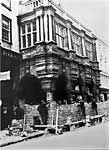 The Guildhall was considered too precious to be left without any protection from
bombing. In February 1941 workman built a brick wall in the front of
the Guildhall to protect it from blast damage – it would have
helped protect it from damage from a blast in the High Street, but it
was still vulnerable from a direct hit. One mother wrote in a letter to
her son "The Guildhall
has been bricked up, It is like going through a tunnel on the pavement
under the arches." Courtesy the Express and Echo.
The Guildhall was considered too precious to be left without any protection from
bombing. In February 1941 workman built a brick wall in the front of
the Guildhall to protect it from blast damage – it would have
helped protect it from damage from a blast in the High Street, but it
was still vulnerable from a direct hit. One mother wrote in a letter to
her son "The Guildhall
has been bricked up, It is like going through a tunnel on the pavement
under the arches." Courtesy the Express and Echo.
 The Saxon, St Lawrence Church on the right had a statue of Elizabeth I over the entrance. Destroyed
in 1942 along with everything else in that part of the High Street.
The Saxon, St Lawrence Church on the right had a statue of Elizabeth I over the entrance. Destroyed
in 1942 along with everything else in that part of the High Street.
HMS Exeter was sunk by a torpedo in the Sunda Straight 1 March 1942.
Walt Disneys film Bambi played at the Exeter Savoy in 1942.
Danny La Rue, the entertainer started his first job at Colsons, as a window dresser in 1942.
Pikes Garage of Alphington Street, Greenslades Coaches and the Devon General Garage were all used to repair Spitfires for the RAF during the war in their workshops.
A
letter home to his parents in Exeter from Gilbert Bell 23rd April
1940. Gilbert served in the RAF as a Flight Lieutenant and was killed
in 1944 in a bombing raid over Germany. He won the DFC.
"I hope the budget will
not affect you, Big
moan among our chaps, one shilling & four pence half penny for
20 cigarettes, When
the BEF can get them for 6 pence. We are fighting the war as much
as any one. Fancy
twopence half penny to send a letter !"
 An advert for Deller's
Cafe in Bedford Street. Many have reminisced
about Deller's as a meeting place amongst a magnificent baroque
interior. A light lunch or tea were accompanied by Gwen Master and her
Orchestra. Destroyed in 1942.
An advert for Deller's
Cafe in Bedford Street. Many have reminisced
about Deller's as a meeting place amongst a magnificent baroque
interior. A light lunch or tea were accompanied by Gwen Master and her
Orchestra. Destroyed in 1942.
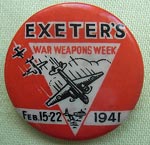 Exeter War Weapons Week ran from the 15th to the 22nd February 1941 with a procession along the High Street. The motto for the week was 'England Expects Extra from Exeter'. This celluloid and metal button badge was made by Thomas Fattorini, Birmingham to be sold as a fund raiser. Photo courtesy of Ian Ritchie.
Exeter War Weapons Week ran from the 15th to the 22nd February 1941 with a procession along the High Street. The motto for the week was 'England Expects Extra from Exeter'. This celluloid and metal button badge was made by Thomas Fattorini, Birmingham to be sold as a fund raiser. Photo courtesy of Ian Ritchie.
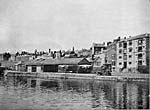 The quay as a working port in the early
1940's. German documents, recovered after the war rated
the port as 3rd grade for usefulness in the event of an invasion.
The quay as a working port in the early
1940's. German documents, recovered after the war rated
the port as 3rd grade for usefulness in the event of an invasion.
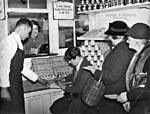 Registering for the meat ration - Exeter houswives are registering for the meat ration
at J.Lethbridge & Sons at 183 Cowick Street. On the
8th January 1940, limits were imposed on the sale of bacon, butter and
sugar. On the 11th March 1940 meat rationing was introduced based on a
limit of 1 shilling per week per person. Courtesy
of Tony Lethbridge
Registering for the meat ration - Exeter houswives are registering for the meat ration
at J.Lethbridge & Sons at 183 Cowick Street. On the
8th January 1940, limits were imposed on the sale of bacon, butter and
sugar. On the 11th March 1940 meat rationing was introduced based on a
limit of 1 shilling per week per person. Courtesy
of Tony Lethbridge
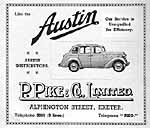 In 1942, P Pike and Co promote the Austin - wonder if they were related to Private Pike of 'Dad's Army'. Pikes
were involved in assembling Spitfires at Exeter airport during the war.
In 1942, P Pike and Co promote the Austin - wonder if they were related to Private Pike of 'Dad's Army'. Pikes
were involved in assembling Spitfires at Exeter airport during the war.
The Blitz - May 1942 and aftermath
Also see
The
Exeter Blitz
Casualties of the Blitz - a
list
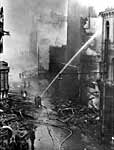 A photo showing
firemen trying to douse the flames as the store Colsons,
in the High Street burns during the raid of May 1942. Courtesy
Express and Echo
A photo showing
firemen trying to douse the flames as the store Colsons,
in the High Street burns during the raid of May 1942. Courtesy
Express and Echo
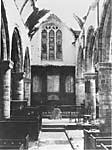 St
Mary Arches Church suffered severe damage during the May 1942
bombing. The church was restored after the war, with the roof repaired
using timbers from a US landing craft from the Normandy invasion. Courtesy
Express and Echo
St
Mary Arches Church suffered severe damage during the May 1942
bombing. The church was restored after the war, with the roof repaired
using timbers from a US landing craft from the Normandy invasion. Courtesy
Express and Echo
 The Odeon
Cinema in Sidwell Street suffered damage from a bomb that
dropped into the street at the front. The facade of the cinema was hit
by shrapnel and the entrance porch was damaged. To this day, the steps
still show chunks knocked out, from the bomb blast.
The Odeon
Cinema in Sidwell Street suffered damage from a bomb that
dropped into the street at the front. The facade of the cinema was hit
by shrapnel and the entrance porch was damaged. To this day, the steps
still show chunks knocked out, from the bomb blast.
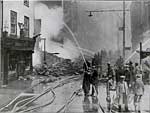 The
fire service fighting
the flames consuming Stones the Chemist in Fore Street. Stones were situated where you will find the Yorkshire
Building Society at 165 Fore Street, next to Adams. Stones relocated to
Mary Arches Street, into what is now Butlers, the public house.
The
fire service fighting
the flames consuming Stones the Chemist in Fore Street. Stones were situated where you will find the Yorkshire
Building Society at 165 Fore Street, next to Adams. Stones relocated to
Mary Arches Street, into what is now Butlers, the public house.
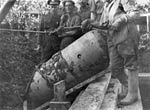 UXB at Culverland Road
- this unexploded bomb was disarmed and removed from Culverland Road
after one of the April 1942 raids. It was found by two children, Nicky
and his sister Caroline Parkin (now Cornish), who saw it poking out of
the ground. Their father who was one of the Parkin Foundry family,
evacuated the road before calling the authorities. This is probably a
500kg general demolition bomb filled with Amatol TNT. The fuse was the
small hole in the side that can be seen facing, while the fins seem to
have been removed. Courtesy of Tony Lethbridge
UXB at Culverland Road
- this unexploded bomb was disarmed and removed from Culverland Road
after one of the April 1942 raids. It was found by two children, Nicky
and his sister Caroline Parkin (now Cornish), who saw it poking out of
the ground. Their father who was one of the Parkin Foundry family,
evacuated the road before calling the authorities. This is probably a
500kg general demolition bomb filled with Amatol TNT. The fuse was the
small hole in the side that can be seen facing, while the fins seem to
have been removed. Courtesy of Tony Lethbridge
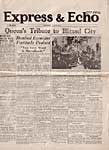 The front cover of the Express and Echo, dated
8th May 1942. The main story is the visit of the King and
Queen to Exeter to see the bomb damage. The King was shown a piece of
shrapnel from a bomb that fell on the Cathedral. He said "Send it for scrap" and the Queen remarked "That's
right, let us send it back to the Germans". ©
- Express and Echo
The front cover of the Express and Echo, dated
8th May 1942. The main story is the visit of the King and
Queen to Exeter to see the bomb damage. The King was shown a piece of
shrapnel from a bomb that fell on the Cathedral. He said "Send it for scrap" and the Queen remarked "That's
right, let us send it back to the Germans". ©
- Express and Echo
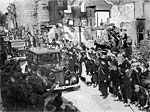 King George VI and Queen
Elizabeth visited Exeter a few days after the blitz of the
4 May to see the damage and encourage the people. They drove through Newtown,
one of the hardest hit areas in the city, with hundreds of people
lining the road to welcome them. Courtesy the Express and Echo.
King George VI and Queen
Elizabeth visited Exeter a few days after the blitz of the
4 May to see the damage and encourage the people. They drove through Newtown,
one of the hardest hit areas in the city, with hundreds of people
lining the road to welcome them. Courtesy the Express and Echo.
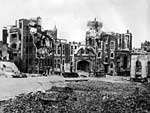 The
sad remains of Dellers Cafe photographed from Bedford Circus. The curved pavement of the circus can
be seen on the left. The entrance to the cafe was from Bedford Street.
Although some thought the cafe could have been saved, it was demolished
on the orders of the town clerk C J Newman. Newman, it was said, had
tried to requisition dynamite, immediately after the bombing raid, to
quickly demolish many buildings, before the historic
buildings experts had a chance to evaluate the damage. Courtesy
Express and Echo.
The
sad remains of Dellers Cafe photographed from Bedford Circus. The curved pavement of the circus can
be seen on the left. The entrance to the cafe was from Bedford Street.
Although some thought the cafe could have been saved, it was demolished
on the orders of the town clerk C J Newman. Newman, it was said, had
tried to requisition dynamite, immediately after the bombing raid, to
quickly demolish many buildings, before the historic
buildings experts had a chance to evaluate the damage. Courtesy
Express and Echo.
 Winston Churchill visited Exeter after the May 1942 blitz. This photo is probably taken in Northernhay
Park. Courtesy Express and Echo.
Winston Churchill visited Exeter after the May 1942 blitz. This photo is probably taken in Northernhay
Park. Courtesy Express and Echo.
 St
Stephen's Church escaped destruction but was quite badly damaged. A fire caused the
bells to fall to the floor, shattering them, but the bronze from their
remains were recast into a new bell. In 2007, contractors who
had stripped the roof tiles in preparation for restoring the roof found
the roof timbers had been fire damaged, and in some places, were mostly
charcoal. After the bombing of May 1942, the roof had caught fire,
unbeknown to anyone, and smouldered for many months before naturally
burning out. The truck is parked just in front of St Stephen's Bow.
St
Stephen's Church escaped destruction but was quite badly damaged. A fire caused the
bells to fall to the floor, shattering them, but the bronze from their
remains were recast into a new bell. In 2007, contractors who
had stripped the roof tiles in preparation for restoring the roof found
the roof timbers had been fire damaged, and in some places, were mostly
charcoal. After the bombing of May 1942, the roof had caught fire,
unbeknown to anyone, and smouldered for many months before naturally
burning out. The truck is parked just in front of St Stephen's Bow.
During the raid of May 4th, 1942, seven members of the Home Guard were killed by a direct hit at their headquaters at Bedford Circus. Their Commanding Officer, Lt Col Hunter was also killed at West Avenue while fire watching.
During the raid, 10,000 incendiary bombs and 75 tons of high explosives dropped on the city. That night, 1400 houses, were destroyed, of which 700 were in Newtown.
After the blitz - 1942 to 1945

 On
the left are quonset huts at the US Navy Camp, Exeter
Golf and Country Club and right, a view of the
clubhouse, during 1943/44. The US Navy arrived in September 1943 to
build the largest stores in Britain to supply the D-Day landing fleet.
They constructed 85 warehouses, 198 huts and 7 miles of road on the
golf course, and handled 19,600 railway wagons at the sidings
at Exeter. Also see the Exeter Story by John Moon. Photo
on the right courtesy Robin Bastin
On
the left are quonset huts at the US Navy Camp, Exeter
Golf and Country Club and right, a view of the
clubhouse, during 1943/44. The US Navy arrived in September 1943 to
build the largest stores in Britain to supply the D-Day landing fleet.
They constructed 85 warehouses, 198 huts and 7 miles of road on the
golf course, and handled 19,600 railway wagons at the sidings
at Exeter. Also see the Exeter Story by John Moon. Photo
on the right courtesy Robin Bastin
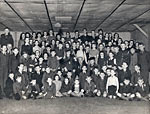 Mayoress
meets children of the blitz 1942 - after the blitz,
attempts were made to look after the children who were made homeless by
the bombing of April and May 1942. Here, the Mayoress, Mrs Glave
Saunders attends a party put on for the blitz affected children of
Exeter. Photo Jane Hoad.
Mayoress
meets children of the blitz 1942 - after the blitz,
attempts were made to look after the children who were made homeless by
the bombing of April and May 1942. Here, the Mayoress, Mrs Glave
Saunders attends a party put on for the blitz affected children of
Exeter. Photo Jane Hoad.
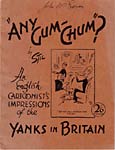 A
cartoon book by Stil,
a local cartoonist, published in Exeter, in 1944, giving a humorous
view of Anglo-American relationships during the build-up to D-day.
Click Sample Cartoons for some
examples
from the book. Thanks to John Moon for the book.
A
cartoon book by Stil,
a local cartoonist, published in Exeter, in 1944, giving a humorous
view of Anglo-American relationships during the build-up to D-day.
Click Sample Cartoons for some
examples
from the book. Thanks to John Moon for the book.
 The Home Guard man an anti-aircraft gun
The Home Guard man an anti-aircraft gun
This photo was provided by Tony Melhuish. It shows his uncle standing on the gun platform, manning, with others, a Bofors anti-aircraft gun at Central Station, circa 1943/4. He worked for Southern Railways, and was a member of the Southern Railways Home Guard. The chimneys are the rear top are in New North Road, with the prison the building on the right – the gun platform would now be in the centre of Isca Place..
Parts for the floating Mulberry Harbour that was used to land supplies on the Normandy beaches were fabricated by Willeys in St Thomas.
In 1942, Clyst Honiton children collected 510 eggs for the Royal Devon & Exeter Hospital Egg Week.
 The Clock
Tower with the Osborne
Hotel behind in 1944. John Moon purchased a camera on his
way through London for 2 guineas - US personnel could afford such a
sum, but it was beyond most British servicemen. Photo
John Moon
The Clock
Tower with the Osborne
Hotel behind in 1944. John Moon purchased a camera on his
way through London for 2 guineas - US personnel could afford such a
sum, but it was beyond most British servicemen. Photo
John Moon
 A 2 penny
programme from the summer of 1942 for the Theatre
Royal. It consisted of only four pages because of paper
shortages. Two plays were: "Young
Woodley" on 17th August 1942 with Paul Scofield in an
early stage appearance, and "Pymalion" on 21st September for one week starring Ellen Pollock, Vernon Masters
and Charles Quatermaine.
A 2 penny
programme from the summer of 1942 for the Theatre
Royal. It consisted of only four pages because of paper
shortages. Two plays were: "Young
Woodley" on 17th August 1942 with Paul Scofield in an
early stage appearance, and "Pymalion" on 21st September for one week starring Ellen Pollock, Vernon Masters
and Charles Quatermaine.
 Doughnut Factory 1944
Doughnut Factory 1944
With so many American troops around the city, before D-Day, it was inevitable that someone would start making doughnuts. This doughnut factory was situated in Preston Street close to the modern Spacexe Gallery. Fourth from left is Nell Badcock nad Joannie Ward, fifth from left. Photo courtesy of Lynn Mclean.
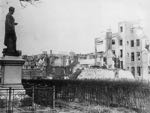 Earl of Devon Statue
Earl of Devon Statue
The blitz left many wastelands across the city. Here, the statue of the Earl of Devon in Bedford Circus stares across the open land that once situated the Devon and Exeter Savings Bank towards the rear of Dellers.
D-Day - 6 June 1944
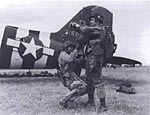 Two 101st Airborne
Division paratroopers on the 5th June preparing to embark on a
C-47 from the Exeter airfield, for the drop zone at Carentan, Normandy.
Other US Divisions in Exeter were the US 29th Infantry Division known
as the 'Blue and Gray' who replaced the 55th British Division, at
Topsham Barracks when they arrived on 1 June 1943. They were moved down
to Cornwall after three months. At D-Day they landed on Omaha Beach.
The US 4th Division or 'Ivy League' replaced them at Topsham. On D-Day,
they landed on Utah Beach, sustaining heavy casualties.
Two 101st Airborne
Division paratroopers on the 5th June preparing to embark on a
C-47 from the Exeter airfield, for the drop zone at Carentan, Normandy.
Other US Divisions in Exeter were the US 29th Infantry Division known
as the 'Blue and Gray' who replaced the 55th British Division, at
Topsham Barracks when they arrived on 1 June 1943. They were moved down
to Cornwall after three months. At D-Day they landed on Omaha Beach.
The US 4th Division or 'Ivy League' replaced them at Topsham. On D-Day,
they landed on Utah Beach, sustaining heavy casualties.
On May 16th 1943, at a ceremony on the County Ground, St Thomas the 1st (Loyal City of Exeter) Battalion Devon Home Guards was presented with its own flag by the City Corporation. They were the first Home Guard unit in the country to have its own flag. The flag now hangs in St Mary Arches Church.
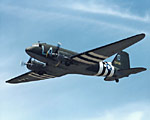 On
D-Day 6th June 1944, Exeter Airport was used as a base for 47 C-47
Skytrains to carry paratroopers of the US 101st Airbourne
Division. They were dropped near Carentan on the Cotentin peninsular.
Three Skytrains failed to return. The next day they returned to
Normandy to drop supplies. Photo Courtesy of Wings of
Silver
On
D-Day 6th June 1944, Exeter Airport was used as a base for 47 C-47
Skytrains to carry paratroopers of the US 101st Airbourne
Division. They were dropped near Carentan on the Cotentin peninsular.
Three Skytrains failed to return. The next day they returned to
Normandy to drop supplies. Photo Courtesy of Wings of
Silver
On 21st May 1944, under great secrecy, the 2nd Battalion Oxfordshire and Buckinghamshire Light Infantry used the swing bridge at Countess Wear to practice attacking Pegasus bridge on the Orne canal on D-Day. The manoeuvres lasted for three days and nights.
Paperwork

 Identity card for a Fire Guard
Identity card for a Fire Guard
Many civilains volunteered to be on fire watch duty at night, to warn and help the public during air raids, Another task was to stand on the roof tops and grab any incendiary bombs by the tail and toss them into the road below, or cover them in sand. This guard belonged to a member of the Eland family, whose bookshop in the High Street was destroyed during the 4th May 1942 blitz. The authorising signature is of Chief Constable A E Rowsell. Courtesy of Richard Holladay.
 Road Tax discs, 1942 and 1943
Road Tax discs, 1942 and 1943
Two road fund tax discs from 1942 and 1943 for a 3 ton, green Bedford goods truck with the registration FFJ858 – the annual cost was £35. It was probably registered to Garton and King. The disc is the same size as a modern tax disc, and it is colour coded for the year, as they are today – notice the English rose, Scottish thistle, Irish clover and Welsh daffodil motifs down the centre. Courtesy of Richard Holladay.

 Essential documents
Essential documents
A
National Registration Identity Card was introduced as a war time
measure in 1939, and finally withdrawn in 1952. The card, left, was
first issued to an Exeter citizen in 1943 and shows clearly how an
individual had to register every new address. The Certificate of Post
War Credit, right, introduced during the war, was a document that
recorded how much tax was paid. The intention was to allow the tax,
with interest, to be repaid after the war. This one was issued by the
tax office at St David's Hill.
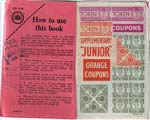
 Clothing Ration book 1947/8
Clothing Ration book 1947/8
Rationing continued into the middle 1950s. This child's Exeter issued
ration book contained coupons for clothing; the value of each coupon
depended on its colour with orange, magenta and olive in the
photo. Scan courtesy of Aubone Braddon.
Post-war Exeter - 1945 to 1949
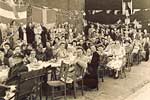 VE Day
in Exe
Island on the 8th May 1945 was welcomed by these residents
with a street party. Although rationing was still in force, local
residents pooled their meagre food supply to bake cakes and provide
drinks for adults and children alike, to celebrate the end of
hostilities in Europe. The party is thought to have been held close to
the Exe Bridge, by Bonhay Road. The photo is courtesy of Jane
Hope whose grandmother is fourth from left, back row.
VE Day
in Exe
Island on the 8th May 1945 was welcomed by these residents
with a street party. Although rationing was still in force, local
residents pooled their meagre food supply to bake cakes and provide
drinks for adults and children alike, to celebrate the end of
hostilities in Europe. The party is thought to have been held close to
the Exe Bridge, by Bonhay Road. The photo is courtesy of Jane
Hope whose grandmother is fourth from left, back row.
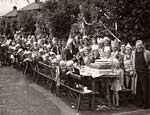
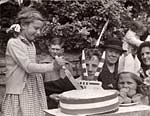 VE Day in Hoker Road The residents of Hoker Road also celebrated VE Day with a street party.
Included in the photo are vicar of Heavitree, the Rev. Johnson, and
Richard Hinchcliffe and Tony Marks, who later played rugby for Exeter
and Hull Kingston Rovers. A cake was cut by Sheila Mairs who later
became a police telephonist at Heavitree. A young Tony Ward of the
builders A D Ward, is behind the knife.
VE Day in Hoker Road The residents of Hoker Road also celebrated VE Day with a street party.
Included in the photo are vicar of Heavitree, the Rev. Johnson, and
Richard Hinchcliffe and Tony Marks, who later played rugby for Exeter
and Hull Kingston Rovers. A cake was cut by Sheila Mairs who later
became a police telephonist at Heavitree. A young Tony Ward of the
builders A D Ward, is behind the knife.
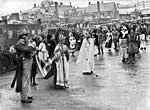 Exeter's Victory procession to mark the end of the war started in the bus station car park at Paul
Street. Here, Britannia, Uncle Sam, the Statue of Liberty and probably,
Joan of Arc are turning up North Street from Paul Street. The Statue of
Liberty, between Britannia and Uncle Sam, was played by Hazel Bowden
who would become W G Hoskins sister-in-law. Photo
courtesy of Angela Marks.
Exeter's Victory procession to mark the end of the war started in the bus station car park at Paul
Street. Here, Britannia, Uncle Sam, the Statue of Liberty and probably,
Joan of Arc are turning up North Street from Paul Street. The Statue of
Liberty, between Britannia and Uncle Sam, was played by Hazel Bowden
who would become W G Hoskins sister-in-law. Photo
courtesy of Angela Marks.
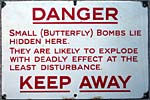 Unexploded bomb sign - Signs like this were seen all over Exeter's bomb sites to warn the
public of UXB's. It is not known where this one came from, apart from
Exeter - it is an enamelled sign which may well have been produced in
the Vulcan Works, Haven Banks. Butterfly bombs were a German
anti-personnel device containing 225 gms of TNT, which was
more than enough to remove a leg, or kill; they were dropped in a
container holding between 6 and 108 bombs. They were the first cluster
bombs to be used in warfare.
Unexploded bomb sign - Signs like this were seen all over Exeter's bomb sites to warn the
public of UXB's. It is not known where this one came from, apart from
Exeter - it is an enamelled sign which may well have been produced in
the Vulcan Works, Haven Banks. Butterfly bombs were a German
anti-personnel device containing 225 gms of TNT, which was
more than enough to remove a leg, or kill; they were dropped in a
container holding between 6 and 108 bombs. They were the first cluster
bombs to be used in warfare.
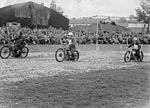
 Exwick
Speedway 1945 This was the European Victory Meeting for charity on Whit
Monday 21st May 1945. Held on Exwick Fields, the hangar type building
is part of W T J (Bill) Eastmond's yard which was beside the Thatched
House Inn. Eastmond was responsible for providing 242 tops off
redundant Morrison shelters
for safety barriers at the speedway track at the County
Ground. He later became a director of Exeter Falcons. The programme for
the event is below. Photo left Tony Lethbridge and program right courtesy Speedway
Swap Shop
Exwick
Speedway 1945 This was the European Victory Meeting for charity on Whit
Monday 21st May 1945. Held on Exwick Fields, the hangar type building
is part of W T J (Bill) Eastmond's yard which was beside the Thatched
House Inn. Eastmond was responsible for providing 242 tops off
redundant Morrison shelters
for safety barriers at the speedway track at the County
Ground. He later became a director of Exeter Falcons. The programme for
the event is below. Photo left Tony Lethbridge and program right courtesy Speedway
Swap Shop
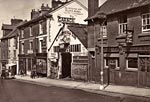 Shepherd's
Garage was Exeter's first to install petrol pumps in 1920. This photo, taken
in the middle 40's shows that the garage still has the same pumps out
the front. The building was demolished in 2007. To the right, on the
site of King Billy's is the old Horse and Groom, demolished and rebuilt
in 1967. Photo Ian Hartnell of Hartnell's Fresh Food
Shepherd's
Garage was Exeter's first to install petrol pumps in 1920. This photo, taken
in the middle 40's shows that the garage still has the same pumps out
the front. The building was demolished in 2007. To the right, on the
site of King Billy's is the old Horse and Groom, demolished and rebuilt
in 1967. Photo Ian Hartnell of Hartnell's Fresh Food
 The
winter of 1947/8 was one of the coldest for years. Coal was in short supply and
transport was severely hit. This photo shows the gardens in front of
Bystock Terrace covered in snow, and not a tyre mark in site. An area
that is now a busy car park, was a garden. Photo courtesy
of Pam Salzman.
The
winter of 1947/8 was one of the coldest for years. Coal was in short supply and
transport was severely hit. This photo shows the gardens in front of
Bystock Terrace covered in snow, and not a tyre mark in site. An area
that is now a busy car park, was a garden. Photo courtesy
of Pam Salzman.
 The Cathedral in 1947 was still undergoing repairs after the May 1942 bombing. The great West
Window was still boarded up to prevent damage from bomb blast. Photo
- Maurice Swansborough
The Cathedral in 1947 was still undergoing repairs after the May 1942 bombing. The great West
Window was still boarded up to prevent damage from bomb blast. Photo
- Maurice Swansborough
 Advert for Redifussion Radio - 1946
Advert for Redifussion Radio - 1946
In the 60s through to the 1980s, Redifussion was a name well known in Exeter for a form of 'cable' TV. This advert shows the company providing 'no fading, no distortion' radio reception. It wasn't until ITV was introduced on 29 April 1961 in the south-west, with Westward Television, that Redifussion started relaying TV via overhead wires strung between houses.
 Ben Johnson passes the swing bridge
Ben Johnson passes the swing bridge
George Monk was in the Royal Navy during the war and took a number of ship photos. He saw the Ben Johnson, a small tanker, approaching the swing bridge at Countess Wear and rode all the way home to Briar Crescent, Burnthouse Lane on his bike, collected his camera and rode back in time to capture the attached photo of the Ben Johnson passing throughPhoto courtesy of Reg Monk.
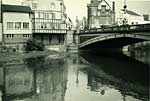 This photograph is a
rather fine detailed study of the Exe
Bridge and the bottom of Bridge Street. Thought to have
been taken in the late 1940's, it could have been taken 50 years
earlier, so little is the change. By 1967 the buildings on the left had
been demolished as work started on the northern Exe crossing. Photo
courtesy of Pam Salzman.
This photograph is a
rather fine detailed study of the Exe
Bridge and the bottom of Bridge Street. Thought to have
been taken in the late 1940's, it could have been taken 50 years
earlier, so little is the change. By 1967 the buildings on the left had
been demolished as work started on the northern Exe crossing. Photo
courtesy of Pam Salzman.
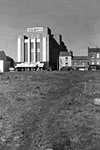 The Odeon
Cinema was confronted by this waste ground in 1949. The
opposite side of Sidwell Street had been destroyed in 1942, and by
1949, the rubble had been cleared and nature was taking over. If you
look carefully when entering the cinema, you will still find chips
knocked out of the steps, due to shrapnel. Photo -
Maurice Swansborough
The Odeon
Cinema was confronted by this waste ground in 1949. The
opposite side of Sidwell Street had been destroyed in 1942, and by
1949, the rubble had been cleared and nature was taking over. If you
look carefully when entering the cinema, you will still find chips
knocked out of the steps, due to shrapnel. Photo -
Maurice Swansborough
 New Aerial view of the city after the bombing. On the 27 June 1946, Bertram Arden a farmer who was an enthusiastic pilot, flew over the city taking photographs. This one shows vividly the damage done to Bedford Circus, the High Street, Sidwell Street and Paris Street. See Aerial Photos for more. Photo Bertram Arden (courtesy of Den Arden)
New Aerial view of the city after the bombing. On the 27 June 1946, Bertram Arden a farmer who was an enthusiastic pilot, flew over the city taking photographs. This one shows vividly the damage done to Bedford Circus, the High Street, Sidwell Street and Paris Street. See Aerial Photos for more. Photo Bertram Arden (courtesy of Den Arden)
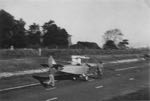 New The Bypass Airfield A farmer, Bertram Arden opened his Bypass Airfield in 1938. In the late 1940s and early 50s, it was a common site to see an aircraft being pushed along the bypass, from the aistrip to the barn/hanger. Photo Bertram Arden (courtesy of Den Arden)
New The Bypass Airfield A farmer, Bertram Arden opened his Bypass Airfield in 1938. In the late 1940s and early 50s, it was a common site to see an aircraft being pushed along the bypass, from the aistrip to the barn/hanger. Photo Bertram Arden (courtesy of Den Arden)

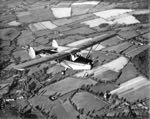 The
first Exeter built Chrislea
Super Ace light aircraft flew for the first time in
February 1948 at Exeter Airport. Seventeen were eventually produced.
They had an innovative control system that some considered to be
dangerous. The only surviving Chrislea Skyjeep, a later variant, is now
based at Eggesford
Airfield, and is airworthy. After her 1hr 20mins test flight
at Exeter in the early fifties she ended up in Australia. Hopefully,
she may be flown back to Exeter in 2007. The photo right is the prototype Super Ace belonging to Bertram Arden and used with the permission of Den Arden. Photo left courtesy of Ed Coates Collection
The
first Exeter built Chrislea
Super Ace light aircraft flew for the first time in
February 1948 at Exeter Airport. Seventeen were eventually produced.
They had an innovative control system that some considered to be
dangerous. The only surviving Chrislea Skyjeep, a later variant, is now
based at Eggesford
Airfield, and is airworthy. After her 1hr 20mins test flight
at Exeter in the early fifties she ended up in Australia. Hopefully,
she may be flown back to Exeter in 2007. The photo right is the prototype Super Ace belonging to Bertram Arden and used with the permission of Den Arden. Photo left courtesy of Ed Coates Collection
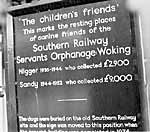
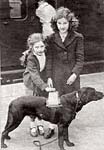 Charity Railway dogs - This memorial was on land adjacent to Central Station. It marks the
burial site of two dogs that raised money for running the London
& South Western Railway Servants Orphanage, now known as Woking
Grange. There was a third dog, named Kim used for the charity which was
run by John Bovett, a railway guard. The dogs, collected
£25,000 over 26 years. The memorial board was vandalised
beyond repair in 2003. The photo, left, shows Sandy collecting on the
platform in 1946 with Janet and Rita Phillips. Photo of sign
David Cornforth
Charity Railway dogs - This memorial was on land adjacent to Central Station. It marks the
burial site of two dogs that raised money for running the London
& South Western Railway Servants Orphanage, now known as Woking
Grange. There was a third dog, named Kim used for the charity which was
run by John Bovett, a railway guard. The dogs, collected
£25,000 over 26 years. The memorial board was vandalised
beyond repair in 2003. The photo, left, shows Sandy collecting on the
platform in 1946 with Janet and Rita Phillips. Photo of sign
David Cornforth
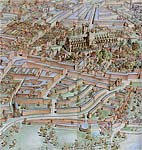
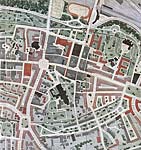 Thomas Sharp's plans and a scale model for the
rebuilding of post war Exeter were put on display at an
exhibition, in 1946, in the city. An artists impression, left shows the
city from Shilhay and the quay, bottom to Princesshay at the top. The
map, right, shows the Cathedral near centre with the bus station on the
site of the Rougemont Hotel at the top and London Inn Square centre
right. Apart from Princesshay, virtually none of Sharp's plan was
implemented.
Thomas Sharp's plans and a scale model for the
rebuilding of post war Exeter were put on display at an
exhibition, in 1946, in the city. An artists impression, left shows the
city from Shilhay and the quay, bottom to Princesshay at the top. The
map, right, shows the Cathedral near centre with the bus station on the
site of the Rougemont Hotel at the top and London Inn Square centre
right. Apart from Princesshay, virtually none of Sharp's plan was
implemented.
 Ice cream makers and sellers in
Exeter were dominated by Italian families. The Forte's ran an ice cream
factory near Mermaid Yard, Preston Street. The Morellis, who were
related, were based in Summerland Street. This photo, dating from
the late 1940s shows the Morelli's with their Devon Cream Ices cart
waiting for customers. The boxes bottom left contained the cones and
wafers made by Ritz.
Ice cream makers and sellers in
Exeter were dominated by Italian families. The Forte's ran an ice cream
factory near Mermaid Yard, Preston Street. The Morellis, who were
related, were based in Summerland Street. This photo, dating from
the late 1940s shows the Morelli's with their Devon Cream Ices cart
waiting for customers. The boxes bottom left contained the cones and
wafers made by Ritz.

 Temporary Shops 1949 – Two thirds of the High Street and part of Sidwell Street was destroyed in the blitz. Temporary shops where built in parts of the city for the former traders. The main block ran from the High Street, opposite the modern Boots, to past the city wall by the modern Giraffe. Left is the middle section of the shops which include Eland the bookshop, and Wippel Bros and Rowe. The last shop close to Southernhay North was Melhuishes. Photos courtesy of David Force.
Temporary Shops 1949 – Two thirds of the High Street and part of Sidwell Street was destroyed in the blitz. Temporary shops where built in parts of the city for the former traders. The main block ran from the High Street, opposite the modern Boots, to past the city wall by the modern Giraffe. Left is the middle section of the shops which include Eland the bookshop, and Wippel Bros and Rowe. The last shop close to Southernhay North was Melhuishes. Photos courtesy of David Force.
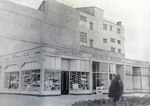

 Temporary Shops 1949 – The western end of the shops, left photo, backed on to the Co-op which escaped the bombing. The area now hosts Next. Two more shops from the centre of the block include Wippel Bros and Row. The last photo shows the view east.
Temporary Shops 1949 – The western end of the shops, left photo, backed on to the Co-op which escaped the bombing. The area now hosts Next. Two more shops from the centre of the block include Wippel Bros and Row. The last photo shows the view east.
The River Exe froze over during the bad winter of 1947.
The Olympic Torch arrived at the Guildhall on Monday 2nd August 1948 on the way to the Olympic Yachting venue at Torquay. Runner Bill Courteney took the torch at Heavitree, from Alan Andrews, who had run from Honiton Clyst, and carried it down the High Street to be met by Mayor W T Slader and Sheriff Mr A J Bovey. The torch, which weighed 2½ lbs, was used by the Mayor to kindle the torch for the next stage to Alphington, carried by G F Roberts of the Plymouth Spartans. See Video Olympic Torch.
H R H Princess Elizabeth opened the Princesshay Commemorative Feature on 21st October 1949.The feature marked the start of the rebuilding of Exeter after the war.
│ Top of Page │